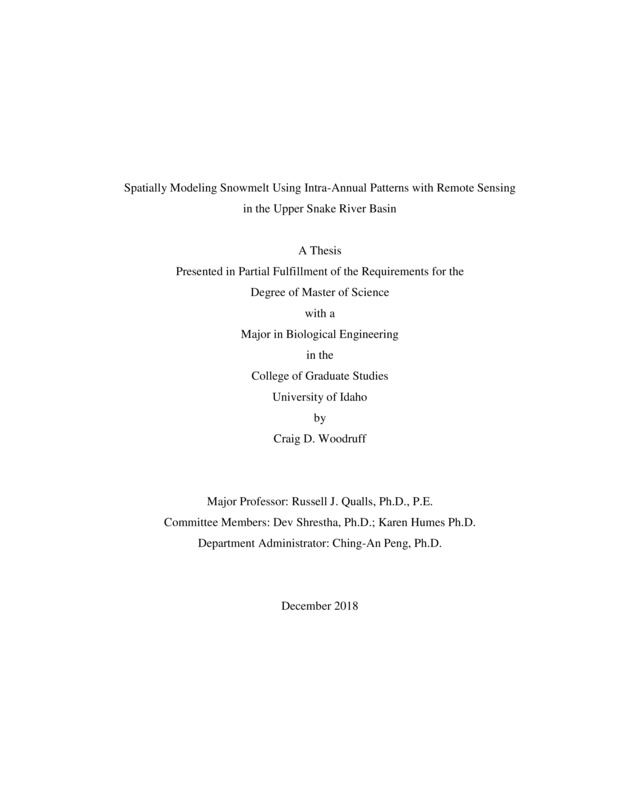Spatially Modeling Snowmelt Using Intra-Annual Patterns with Remote Sensing in the Upper Snake River Basin
Woodruff, Craig Donald. (2018-12). Spatially Modeling Snowmelt Using Intra-Annual Patterns with Remote Sensing in the Upper Snake River Basin. Theses and Dissertations Collection, University of Idaho Library Digital Collections. https://www.lib.uidaho.edu/digital/etd/items/woodruff_idaho_0089n_11485.html
- Title:
- Spatially Modeling Snowmelt Using Intra-Annual Patterns with Remote Sensing in the Upper Snake River Basin
- Author:
- Woodruff, Craig Donald
- Date:
- 2018-12
- Embargo Remove Date:
- 2020-07-08
- Keywords:
- Cloud Removal MODIS Remote Sensing Snow
- Program:
- Biological & Agricultural Engineering
- Subject Category:
- Remote sensing; Hydrologic sciences
- Abstract:
-
Snowmelt represents an important component of the hydrologic cycle with implications for water managers. In this research we assess the applicability of intra-annual patterns for use in spatially modeling snowmelt. This is done through remote sensing which offers daily imagery of the watershed for the time period between 2000 and 2018. This thesis assesses the applicability of intra-annual patterns first and develops two spatial models describing snow extent throughout a melting season.
In the first chapter we identify whether a pattern exists using spatial statistics and spatial comparisons. This fundamental step is the foundation for developing a model. We then address a critical assumption in the second chapter. Modeling the snowmelt progression is often done with depletion curves. We narrow the error bounds solidifying the choice of curve we use to represent melt from year to year and even create a dimensionless curve which can be applied to many years.
The heart of this research is developing a spatial model which combines years of spatial data to describe the melting patterns. This is accomplished in chapter 3 with a principal component analysis. The model developed using information from 2000 through 2016 is applied to the snowmelt seasons of 2017 and 2018 to verify the spatial accuracy.
The final chapter creates another spatial model using a fundamentally different statistical approach. Not only are the results very similar using these two methods both can be accomplished quickly opening the door to further research into the widespread use of this type of model. Applications of both are not limited to real-time modeling, but can be applied to climate change modeling, cloud removal, and even produce spatially distributed information in ungauged watersheds.
- Description:
- masters, M.S., Biological & Agricultural Engineering -- University of Idaho - College of Graduate Studies, 2018-12
- Major Professor:
- Qualls, Russell J
- Committee:
- Shrestha, Dev; Humes, Karen
- Defense Date:
- 2018-12
- Identifier:
- Woodruff_idaho_0089N_11485
- Type:
- Text
- Format Original:
- Format:
- application/pdf
- Rights:
- In Copyright - Educational Use Permitted. For more information, please contact University of Idaho Library Special Collections and Archives Department at libspec@uidaho.edu.
- Standardized Rights:
- http://rightsstatements.org/vocab/InC-EDU/1.0/

